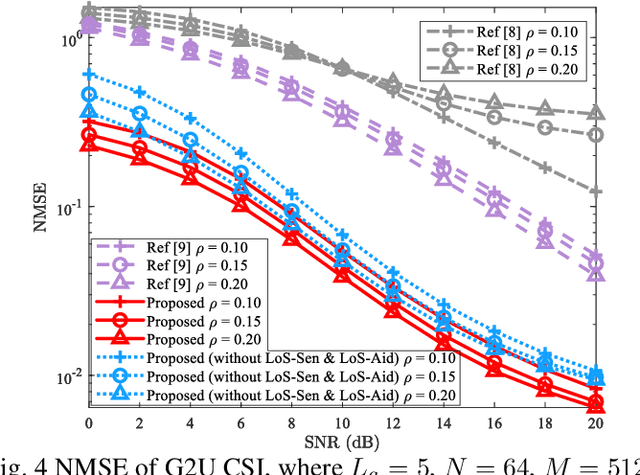Jinliang Chen
LoS sensing-based superimposed CSI feedback for UAV-Assisted mmWave systems
Feb 21, 2023



Abstract:In unmanned aerial vehicle (UAV)-assisted millimeter wave (mmWave) systems, channel state information (CSI) feedback is critical for the selection of modulation schemes, resource management, beamforming, etc. However, traditional CSI feedback methods lead to significant feedback overhead and energy consumption of the UAV transmitter, therefore shortening the system operation time. To tackle these issues, inspired by superimposed feedback and integrated sensing and communications (ISAC), a line of sight (LoS) sensing-based superimposed CSI feedback scheme is proposed. Specifically, on the UAV transmitter side, the ground-to-UAV (G2U) CSI is superimposed on the UAVto-ground (U2G) data to feed back to the ground base station (gBS). At the gBS, the dedicated LoS sensing network (LoSSenNet) is designed to sense the U2G CSI in LoS and NLoS scenarios. With the sensed result of LoS-SenNet, the determined G2U CSI from the initial feature extraction will work as the priori information to guide the subsequent operation. Specifically, for the G2U CSI in NLoS, a CSI recovery network (CSI-RecNet) and superimposed interference cancellation are developed to recover the G2U CSI and U2G data. As for the LoS scenario, a dedicated LoS aid network (LoS-AidNet) is embedded before the CSI-RecNet and the block of superimposed interference cancellation to highlight the feature of the G2U CSI. Compared with other methods of superimposed CSI feedback, simulation results demonstrate that the proposed feedback scheme effectively improves the recovery accuracy of the G2U CSI and U2G data. Besides, against parameter variations, the proposed feedback scheme presents its robustness.
CNN-based Timing Synchronization for OFDM Systems Assisted by Initial Path Acquisition in Frequency Selective Fading Channel
Dec 06, 2022Abstract:Multi-path fading seriously affects the accuracy of timing synchronization (TS) in orthogonal frequency division multiplexing (OFDM) systems. To tackle this issue, we propose a convolutional neural network (CNN)-based TS scheme assisted by initial path acquisition in this paper. Specifically, the classic cross-correlation method is first employed to estimate a coarse timing offset and capture an initial path, which shrinks the TS search region. Then, a one-dimensional (1-D) CNN is developed to optimize the TS of OFDM systems. Due to the narrowed search region of TS, the CNN-based TS effectively locates the accurate TS point and inspires us to construct a lightweight network in terms of computational complexity and online running time. Compared with the compressed sensing-based TS method and extreme learning machine-based TS method, simulation results show that the proposed method can effectively improve the TS performance with the reduced computational complexity and online running time. Besides, the proposed TS method presents robustness against the variant parameters of multi-path fading channels.
 Add to Chrome
Add to Chrome Add to Firefox
Add to Firefox Add to Edge
Add to Edge